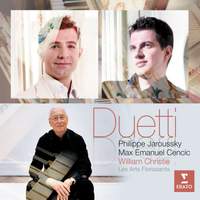Recording of the Week,
Duetti da Camera: Philippe Jaroussky & Max Emanuel Cencic
When I first heard that Max Emanuel Cencic and Philippe Jaroussky had a duets disc in the pipeline (back in July, I think), I was immediately intrigued: not only are these two immensely distinctive and charismatic countertenors two of my favourite singers of the moment, but I was tremendously curious as to what the repertoire might be. Duets aren’t exactly thick on the ground in baroque opera (you’re lucky if you get one or two per evening amid the plethora of da capo arias), and those for two similar voice-types are even rarer. When the finished copy landed on my desk a few weeks ago, it transpired that they’ve eschewed operatic repertoire altogether in favour of exploring ‘duetti da camera’ and duet cantatas (definitions to follow!) by a handful of relatively obscure Italian composers from around the turn of the eighteenth century and just after: Bononcini and Marcello contribute the lion’s share, with little gems from Mancini, Porpora, Alessandro Scarlatti and Francesco Conti along the way.

As the musicologist Susanne Kessler explains at length in her excellent booklet note, the ‘duetto da camera’ was in part a response to the papal ban on opera in Rome in the early eighteenth century – and as the edict also forbade women from singing in public, the cantatas on this disc were necessarily written for castrati. Most of these works last around ten minutes and combine recitative dialogue with duet (the ‘duetto da camera’) or with arias for each singer in turn (the ‘chamber duet’). Both are secular forms, typically setting a pastoral ‘nymphs-and-shepherds’ text written by one or more of the scholars, amateur poets or even cardinals who attended ‘conversazione’ (something akin to modern-day summer schools!) in Rome and Naples in order to exchange ideas and foster their appreciation of music and the other arts.
I shan’t pretend that any of the texts exactly make for scintillating drama on their own terms – most of them are variants on the lovesick-shepherd-longing-for-his-mistress idea – but they do inspire real inventiveness and character in the various composers. In each instance the singers perform as named characters (rather than just ‘soprano I/II’): sometimes they are friends consoling one another in their lovers’ absence, sometimes rivals who eventually reach an understanding. In one of the most memorable works (the Conti) they are respectively lucky and unlucky-in-love, singing intertwining lines to similar but slightly modified text. (Interestingly, none of the works are love duets – though the disc opens with a female-female duet, suggesting that it was fine for male singers to sing as women characters, perhaps it would have been taboo for two castrati to impersonate lovers in this context.)
Though both singers are designated ‘countertenor’ in the sleeve notes, Jaroussky and Cencic push the term to its limits. Cencic’s repertoire includes bona fide mezzo roles such as Prince Orlofsky in Die Fledermaus; Jaroussky is currently winning plaudits for his exquisitely floated Pie Jesu on Paavo Jarvi’s new Faure Requiem and will sing the role of Sesto in Giulio Cesare (written for the female soprano Margherita Durastanti) at next year’s Salzburg Festival.
As I mentioned in my recent newsletter on Vivaldi’s Farnace and Gluck’s Ezio, Cencic’s high-lying, vibrant instrument sounds much as I imagine the great castrati to have done and is something entirely distinct from the earlier generation of countertenors such as Andreas Scholl, René Jacobs or Michael Chance. Jaroussky’s voice sits even higher: more male soprano than male alto, he has no problem sitting around or even above the top of the treble stave for long periods, and so generally takes the top line in the duets.
In his brief but touching foreword, conductor William Christie vividly describes the impact of first hearing these two unique voices together – when they played husband and wife in his 2007 production of Landi’s Il Sant’ Alessio – and one of the most remarkable features of this disc is how the pair manage to blend so utterly seamlessly when singing together whilst remaining absolutely distinctive in the solo passages (not once did I have to check the track listing to see who was singing what). Cencic’s voice has the darker timbre, with plenty of metallic 'ring' throughout the registers, whilst Jaroussky is sweeter and more ethereal. Each gets a solo cantata (inevitably, in the persona of a shepherd) which plays to these strengths, Jaroussky’s by Mancini (all limpid streams and flowery banks) and Cencic’s by Porpora (listen to the thrilling bite in his voice in the 'b' section as he sings of the savage beasts who threaten his flock).
This is an absolutely beautiful disc, far more than just a virtuoso ‘two countertenors and a theorbo’ novelty (though of course it is that too!). The singing is scintillatingly, breathtakingly classy, and the central concept unearths some real delights in a genre that’s not at all well represented on disc. What’s more, a lot of this hitherto-unknown repertoire is deliciously catchy (I defy anyone not to find themselves whistling the final track in particular after just a couple of hearings).
Sound samples and a video (in a mixture of French and English, but without subtitles for either!) are available as usual via the links below. Do try it!
Philippe Jaroussky (countertenor) & Max Emanuel Cencic (countertenor), Les Arts Florissants, William Christie
Available Formats: MP3, FLAC



